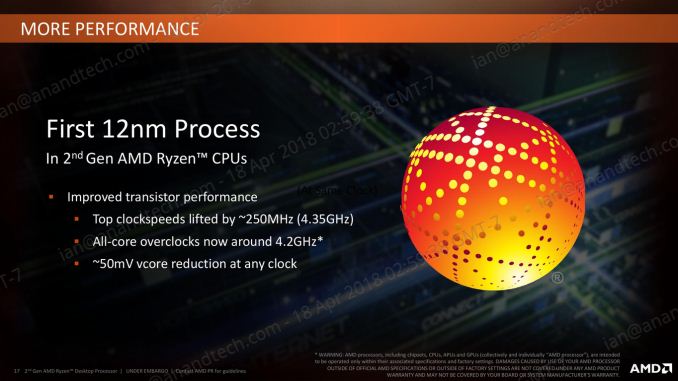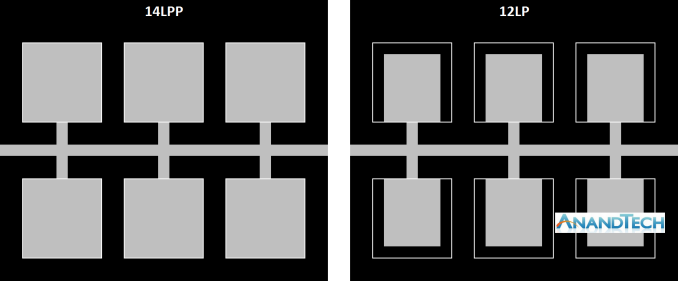The AMD 2nd Gen Ryzen Deep Dive: The 2700X, 2700, 2600X, and 2600 Tested
by Ian Cutress on April 19, 2018 9:00 AM ESTTalking 12nm and Zen+
One of the highlights of the Ryzen 2000-series launch is that these processors use GlobalFoundries’ 12LP manufacturing process, compared to the 14LPP process used for the first generation of Ryzen processors. Both AMD and GlobalFoundries have discussed the differences in the processes, however it is worth understanding that each company has different goals: AMD only needs to promote what helps its products, whereas GlobalFoundries is a semiconductor foundry with many clients and might promote ideal-scenario numbers. Earlier this year we were invited to GlobalFoundries Fab 8 in upstate New York to visit the clean room, and had a chance to interview Dr. Gary Patton, the CTO.
The Future of Silicon: An Exclusive Interview with Dr. Gary Patton, CTO of GlobalFoundries
In that interview, several interesting items came to light. First, that the CTO doesn’t necessarily have to care much about what certain processes are called: their customers know the performance of a given process regardless of the advertised ‘nm’ number based on the development tools given to them. Second, that 12LP is a series of minor tweaks to 14LPP, relating to performance bumps and improvements that come from a partial optical shrink and a slight change in manufacturing rules in the middle-line and back-end of the manufacturing process. In the past this might not have been so news worthy, however GF’s customers want to take advantage of the improved process.
Overall, GlobalFoundries has stated that its 12LP process offers a 10% performance improvement and a 15% circuit density improvement over 14LPP.
This has been interpreted in many ways, such as an extra 10% frequency at the same power, or lower power for the same frequency, and an opportunity to build smaller chips.
As part of today’s launch, AMD has clarified what the move to 12LP has meant for the Ryzen 2000-series:
- Top Clock Speeds lifted by ~250 MHz (~6%)
- All-core overclocks around 4.2 GHz
- ~50 mV core voltage reduction
AMD goes on to explain that at the same frequency, its new Ryzen 2000-series processors draw around 11% less power than the Ryzen 1000-series. The claims also state that this translates to +16% performance at the same power. These claims are a little muddled, as AMD has other new technologies in the 2000-series which will affect performance as well.
One interesting element is that although GF claims that there is a 15% density improvement, AMD is stating that these processors have the same die size and transistor count as the previous generation. Ultimately this seems in opposition to common sense – surely AMD would want to use smaller dies to get more chips per wafer?
Ultimately, the new processors are almost carbon copies of the old ones, both in terms of design and microarchitecture. AMD is calling the design of the cores as ‘Zen+’ to differentiate them to the previous generation ‘Zen’ design, and it mostly comes down to how the microarchitecture features are laid out on the silicon. When discussing with AMD, the best way to explain it is that some of the design of the key features has not moved – they just take up less area, leaving more dark silicon between other features.
Here is a very crude representation of features attached to a data path. On the left is the 14LPP design, and each of the six features has a specific size and connects to the bus. Between each of the features is the dark silicon – unused silicon that is either seen as useless, or can be used as a thermal buffer between high-energy parts. On the right is the representation of the 12LP design – each of the features have been reduced in size, putting more dark silicon between themselves (the white boxes show the original size of the feature). In this context, the number of transistors is the same, and the die size is the same. But if anything in the design was thermally limited by the close proximity of two features, there is now more distance between them such that they should interfere with each other less.
For reference, AMD lists the die-size of these new parts as 213mm2, containing 4.8 billion transistors, identical to the first generation silicon design. AMD confirmed that they are using 9T transistor libraries, also the same as the previous generation, although GlobalFoundries offers a 7.5T design as well.
So is Zen+ a New Microarchitecture, or Process Node Change?
Ultimately, nothing about most of the Zen+ physical design layout is new. Aside from the manufacturing process node change and likely minor adjustments, the rest of the adjustments are in firmware and support:
- Cache latency adjustments leading to +3% IPC
- Increased DRAM Frequency Support to DDR4-2933
- Better voltage/frequency curves, leading to +10% performance overall
- Better Boost Performance with Precision Boost 2
- Better Thermal Response with XFR2













545 Comments
View All Comments
utmode - Saturday, April 21, 2018 - link
Thank you Ian for testing on Latest Win10 patch.eva02langley - Saturday, April 21, 2018 - link
All this because of 1080p gaming benchmarks...All this circus for a benchmark,
1. with an enthusiast GPU
2. with a high end CPU
3. at 1080p
4. and affecting only 144hz users
This bench needs to be gone. It is misleading and inaccurate depending if the GPU is bottleneck or not. Joe Blo looking at these, don't understand that buying a RX 580, is not going to get out the same thing from extracting the results out of these stupid CPU benchmarks at 1080p.
Joe Blo is not going to know until he sees budget, high end and enthusiasm GPU in plays with his intended CPU purchase. WE KNOW, but they don't.
All this for a stupid bench that impact 1080p @ 144HZ users.
I am having a 1080 TI @ 2160p, I can tell you that this stupid bench doesn't do jack in my situation... but the multi-threaded results does.
wizyy - Saturday, April 21, 2018 - link
Well, although admittedly there are users that aren't interested in 1080p 144Hz performance numbers, there are LARGE sum of players that need exactly that.Cybercafe that I'm administering, for one, has 40 PCs with 40 144Hz monitors.
eva02langley - Monday, April 23, 2018 - link
My point is that by looking at numbers, you can get the wrong idea.Unless you test a budget, mid range and high-end GPU at 1080p, 1440p and 2160p with a specified CPU, you don't get a clear picture.
As of today, this bench is only specific to 1080p @ 144Hz which represent a really % of potential users.
Like I was saying, I am at 2160p, this render this bench totally useless. GPU bottleneck is going to be more and more present in the future because resolution is just increasing.
mapesdhs - Monday, May 14, 2018 - link
There aren't large numbers at all. The no. of gamers who use high frequency monitors of any kind is a distinct minority. Irony is they're resensitising their visual system to *need* higher refresh rates, and they can't go back (ref New Scientis article last year IIRC). IMO this whole push for high refresh rates is just a sideways move by the industry because nobody bothers introducing new visual features anymore, there's been nothing new on that front for many years. Nowadays it's just performance, and encouraging refresh is one way of pushing it. How convenient that these things came a long just as GPU tech had become way more than powerful enough to run any game at 60Hz locked.mapesdhs - Monday, May 14, 2018 - link
(I was replying to wizyy btw; why does the reply thing put messages in the wrong place? This forum system is so outdated, and still can't edit)aliquis - Saturday, April 21, 2018 - link
You are simply wrong.Doing say 4K benchmarks would just make people think it doesn't matter which CPU you have and all are the same for gaming which is totally wrong and inaccurate.
Benchmarks for CPU game performance should definitely be done at a low resolution and with a powerful graphics card. Sweclockers still did 720p medium. The problem with medium is that you may lower the load on the CPU for things such as physics and reflections. Still valid for high fps gamers but maybe should be combined with a higher setting too in case that use more CPU. Ultra as worst case scenario.
Opposite of your suggestion which basically result in no data and hence you could just as well not benchmarks games whatsoever instead do it at a low resolution but then simple conclude something like "Even an i3 or Ryzen 3 is enough to achieve a 60 fps avg experience" for instance. If that was the case. Then it would still be accurate and useful and people could decide themselves how much they care about 140 or 180 fps.
All these idiots who claim the Intel lead is only there I low resolutions are wrong and fool others. The Intel lead in executing game code is always there. It's just that you of course need to have a strong enough gpu vs settings and resolution to be able to appreciate / get it too. But that run in both directions. On YouTube someone tested for instance project cars on the new cpus and he had little above 50% gpu load so obviously didn't used it all and was bottleneck ed by the CPU performance yet only used just over 20% of the CPU which for the uneducated may seem like pooh the Ryzen is so powerful for games with so much headroom but it's not because clearly one (virtual) core was fully utilised and couldn't offer more performance and the rest and unused capacity was and is irrelevant for the game performance because the game aren't using it anyway. It doesn't help to have unused cores. It do help to have more powerful ones though.
aliquis - Saturday, April 21, 2018 - link
And avg 144 fps isn't enough. Lows matter and even then even shorter frame times would get even more up to date images if vsync off.But sure if all frame times are below 1/144 s you're likely fine in that situation. But a few at 1/50s isn't perfect.
mapesdhs - Monday, May 14, 2018 - link
144 isn't enough? :D That's hillarious. Welcome to the world of gamers who sensitised themselves away from normal refresh rates, and now they can't go back. You're chasing moving goal posts. Look up the article in New Scientist about this.Singuy888 - Saturday, April 21, 2018 - link
It doesn't matter which CPU you choose for gaming. That's the point but people like to dig up tech from 10 years ago to prove one vs the other. Games are going multithreaded and even Intel is pushing this. So 1080p heavy single threaded gaming benchmank is misleading unless you like living in the past. You win with ryzen @ 1440P or above and you win with future highly multithreaded games. But nope..let's just test world of Warcraft at 720p to show Intel's dominance because that's the future?